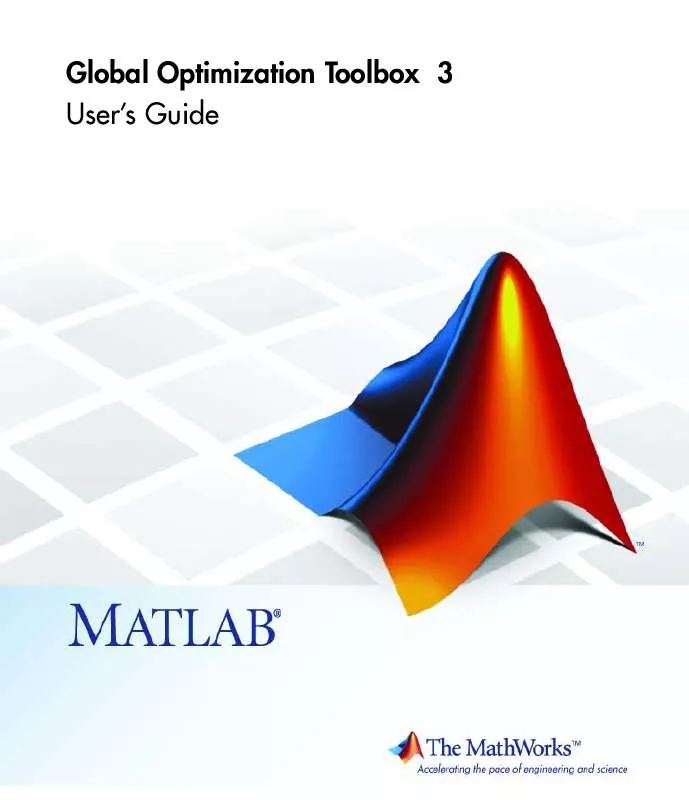Detailed instructions for use are in the User's Guide.
[. . . ] Global Optimization Toolbox 3 User's Guide
How to Contact The MathWorks
Web Newsgroup www. mathworks. com/contact_TS. html Technical Support
www. mathworks. com comp. soft-sys. matlab suggest@mathworks. com bugs@mathworks. com doc@mathworks. com service@mathworks. com info@mathworks. com
Product enhancement suggestions Bug reports Documentation error reports Order status, license renewals, passcodes Sales, pricing, and general information
508-647-7000 (Phone) 508-647-7001 (Fax) The MathWorks, Inc. 3 Apple Hill Drive Natick, MA 01760-2098
For contact information about worldwide offices, see the MathWorks Web site. Global Optimization Toolbox User's Guide © COPYRIGHT 20042010 by The MathWorks, Inc.
The software described in this document is furnished under a license agreement. The software may be used or copied only under the terms of the license agreement. [. . . ] A more deterministic selection option is Remainder, which performs two steps: · In the first step, the function selects parents deterministically according to the integer part of the scaled value for each individual. For example, if an individual's scaled value is 2. 3, the function selects that individual twice as a parent.
5-62
Genetic Algorithm Examples
· In the second step, the selection function selects additional parents using the fractional parts of the scaled values, as in stochastic uniform selection. The function lays out a line in sections, whose lengths are proportional to the fractional part of the scaled value of the individuals, and moves along the line in equal steps to select the parents. Note that if the fractional parts of the scaled values all equal 0, as can occur using Top scaling, the selection is entirely deterministic.
Reproduction Options
Reproduction options control how the genetic algorithm creates the next generation. The options are · Elite count -- The number of individuals with the best fitness values in the current generation that are guaranteed to survive to the next generation. These individuals are called elite children. When Elite count is at least 1, the best fitness value can only decrease from one generation to the next. This is what you want to happen, since the genetic algorithm minimizes the fitness function. Setting Elite count to a high value causes the fittest individuals to dominate the population, which can make the search less effective. · Crossover fraction -- The fraction of individuals in the next generation, other than elite children, that are created by crossover. "Setting the Crossover Fraction" on page 5-66 describes how the value of Crossover fraction affects the performance of the genetic algorithm.
Mutation and Crossover
The genetic algorithm uses the individuals in the current generation to create the children that make up the next generation. Besides elite children, which correspond to the individuals in the current generation with the best fitness values, the algorithm creates · Crossover children by selecting vector entries, or genes, from a pair of individuals in the current generation and combines them to form a child · Mutation children by applying random changes to a single individual in the current generation to create a child
5-63
5
Using the Genetic Algorithm
Both processes are essential to the genetic algorithm. Crossover enables the algorithm to extract the best genes from different individuals and recombine them into potentially superior children. Mutation adds to the diversity of a population and thereby increases the likelihood that the algorithm will generate individuals with better fitness values. See "Creating the Next Generation" on page 5-22 for an example of how the genetic algorithm applies mutation and crossover. You can specify how many of each type of children the algorithm creates as follows: · Elite count, in Reproduction options, specifies the number of elite children. · Crossover fraction, in Reproduction options, specifies the fraction of the population, other than elite children, that are crossover children. For example, if the Population size is 20, the Elite count is 2, and the Crossover fraction is 0. 8, the numbers of each type of children in the next generation are as follows: · There are two elite children. · There are 18 individuals other than elite children, so the algorithm rounds 0. 8*18 = 14. 4 to 14 to get the number of crossover children. · The remaining four individuals, other than elite children, are mutation children.
Setting the Amount of Mutation
The genetic algorithm applies mutations using the option that you specify on the Mutation function pane. The default mutation option, Gaussian, adds a random number, or mutation, chosen from a Gaussian distribution, to each entry of the parent vector. Typically, the amount of mutation, which is proportional to the standard deviation of the distribution, decreases at each new generation. [. . . ] Use empty matrices for lb and ub if no bounds exist. Set lb(i) to -Inf if x(i) is unbounded below; set ub(i) to Inf if x(i)
Description
is unbounded above.
x = simulannealbnd(fun, x0, lb, ub, options) minimizes with the default optimization parameters replaced by values in the structure options, which can be created using the saoptimset function. See the saoptimset reference page for details. x = simulannealbnd(problem) finds the minimum for problem, where problem is a structure containing the following fields: objective x0 lb ub rngstate
Objective function Initial point of the search Lower bound on x Upper bound on x Optional field to reset the state of the random number generator
12-69
simulannealbnd
solver options
'simulannealbnd'
Options structure created using saoptimset
Create the structure problem by exporting a problem from Optimization Tool, as described in "Importing and Exporting Your Work" in the Optimization Toolbox documentation.
[x, fval] = simulannealbnd(. . . ) returns fval, the value of the
objective function at x.
[x, fval, exitflag] = simulannealbnd(. . . ) returns exitflag,
an integer identifying the reason the algorithm terminated. [. . . ]


